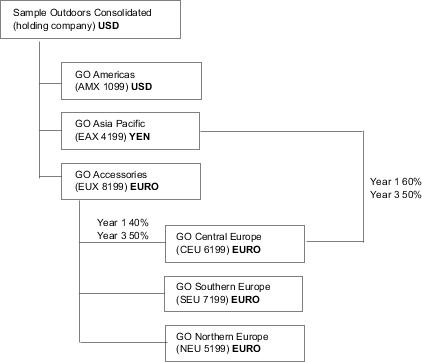The Sample Outdoors Group of Companies
To look for samples that use particular product features, see the individual sample descriptions in this section.
Revenue for The Sample Outdoors Company comes from corporate stores and from franchise operations. The revenues are consolidated from the wholly-owned subsidiaries. There are six distinct organizations, each with its own departments and sales branches. Five of these are regionally-based companies.
The sixth company, GO Accessories:
- Has its own collection of products, differentiated from the other GO companies by brand, name, price, color and size.
- Sells from a single branch to all regions and retailers.
- Functions both as an operating company based in Geneva, and as a part owner of the three GO subsidiaries in Europe.
The following diagram illustrates the consolidated corporate structure of the Sample Outdoors Company. The diagram also includes the percentage changes in ownership for GO Central Europe, and the reporting currency and GL (general ledger) prefix for each subsidiary. In year 1, GO Asia Pacific owns 60% of GO Central Europe, and in year 3, its ownership decreases to 50%. In year 1, GO Accessories owns 40% of GO Central Europe, and in year 3 its ownership increases to 50%.

Each corporation in the Sample Outdoors Company has the same departmental structure and the same general ledger (GL) structure, as shown in the following table. Divisions may not report in the same currencies. For example, the Americas subsidiary reports in US dollars, but the Corporate division local currency reports in Canadian dollars, and the Operations division local currency is pesos.
Division (GL) |
Department (GL) |
|---|---|
Corporate (1700) |
Sales (1720) Marketing (1750) IS&T (1760) Human Resources (1730) Finance (1740) Procurement (1710) |
Operations (1800) |
Production and Distribution (1820) Customer Service (1820) |
Each corporation has a complete chart of accounts. Most of the accounts, such as those under non-personnel expenses, are at the department level, and contain only summary amounts. For example, although each marketing department has expenses, the cost is unspecified at the transaction level where marketing promotions occur.
